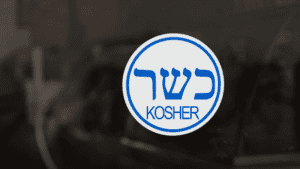Last Updated on February 28, 2025 by Packoi Team
Packaging symbols represent various storage, delivery, and handling instructions for exporters. They also provide product safety and recycling information for end customers.
Though some symbols are intuitive and easy to understand, others are much more confusing. So, here is your ultimate guide to packaging symbols to cut through all this confusion.
32 Important Packaging Symbols
The following are the most commonly used symbols present on shipping boxes and cartons: These symbols have been categorized into four groups for better understanding.
- Package Protection Symbols
- Package Handling Instructions
- Health and Safety Information
- Recycling Details
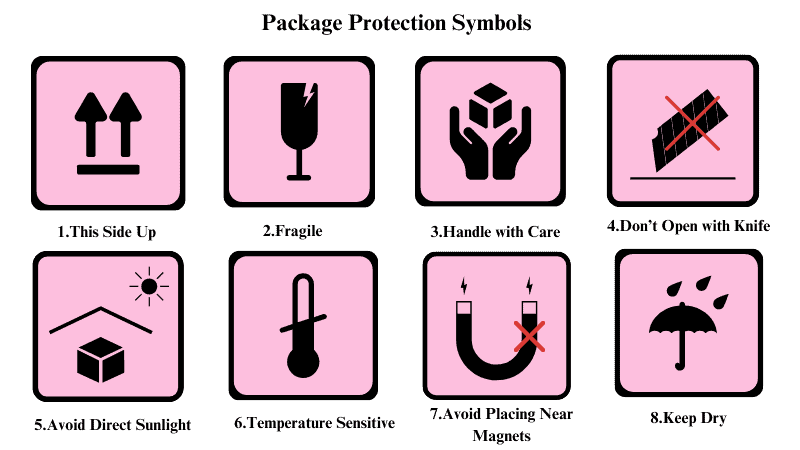
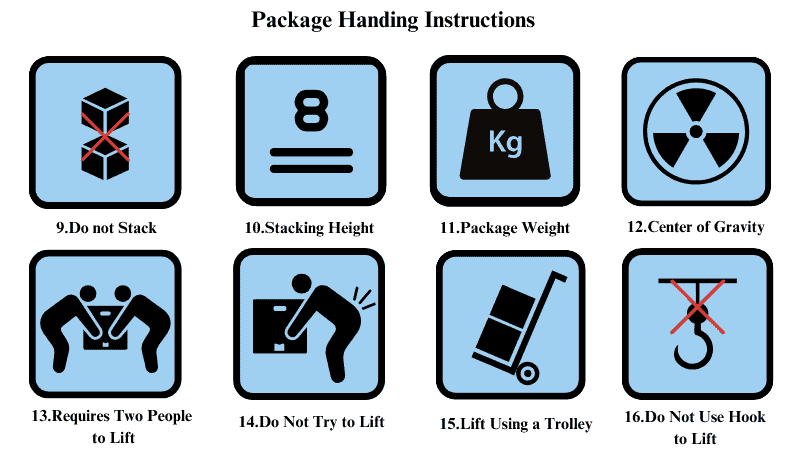
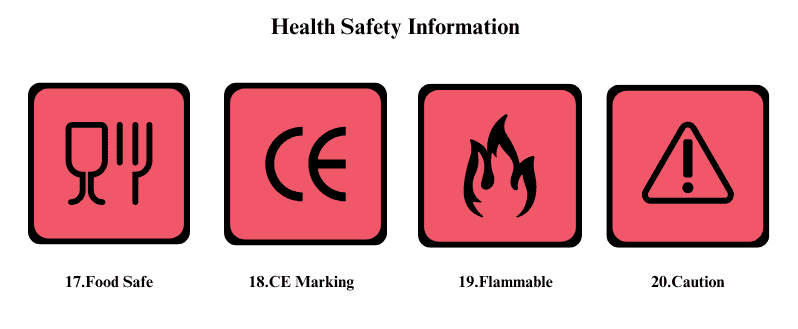
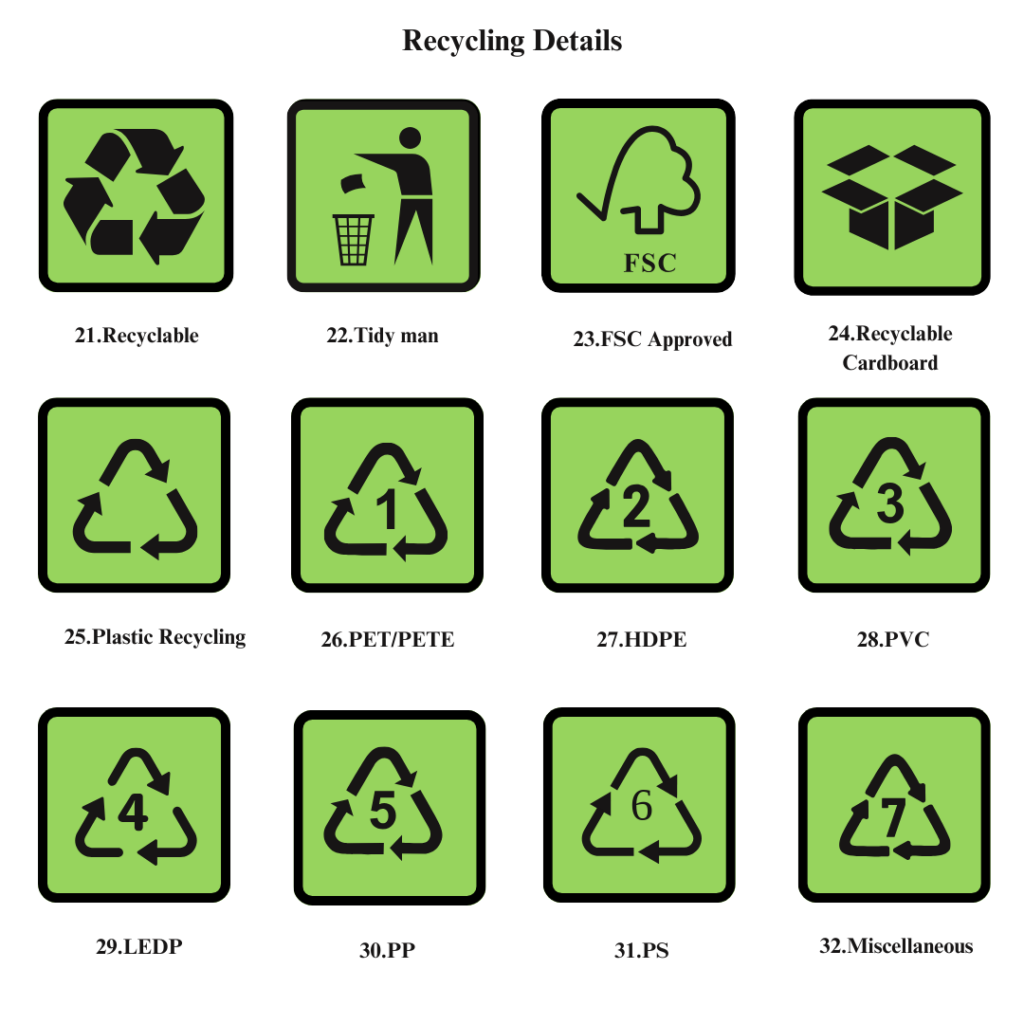
Category 1 Packaging Symbols for Protecting Contents
Package protection and care symbols are necessary for any product susceptible to damage during shipping. These symbols reflect the product properties without divulging the contents of the package. A logo identifying packaging products is more convenient than a written summary.
Fragile Products
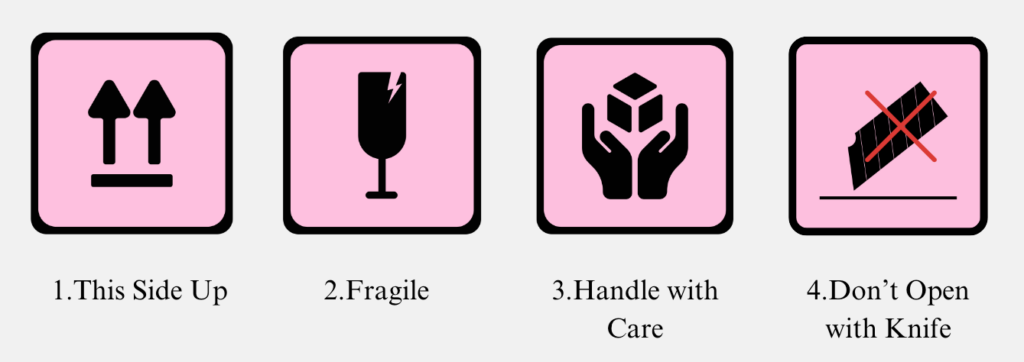
Some products are more prone to damage during shipping than others. Protection symbols explain the degree of care required to handle a package.
1. This Side Up
This common packaging symbol indicates the package contains a complex product that must be placed upright at all costs. Storing or moving the box on its side or turning it upside down will cause severe damage to the contents. You can easily identify this symbol as two vertical arrows pointing upwards.
Example: Heavy Machinery and Laboratory Instruments.
2. Fragile
Products that can easily break or shatter from unexpected shocks or jerks are labeled as fragile. The symbol here shows a wine glass with a crack indicating the fragility of the contents.
Examples: Glass and Porcelain Products.
3. Handle with Care
The handle with care symbol provides slightly different instructions from the fragile symbol. These products won’t crack or shatter easily, but they will get damaged if mishandled. So packages with this symbol must not be stacked and placed down gently.
Examples: Smartphones, Television Sets, and Laptops.
4. Do Not Open with a Knife
Using a knife to open the package may result in the contents being damaged. This symbol provides safety instructions to the end user.
Examples: Pillows, Books, and Mattresses
Safe Storage and Packing Symbols
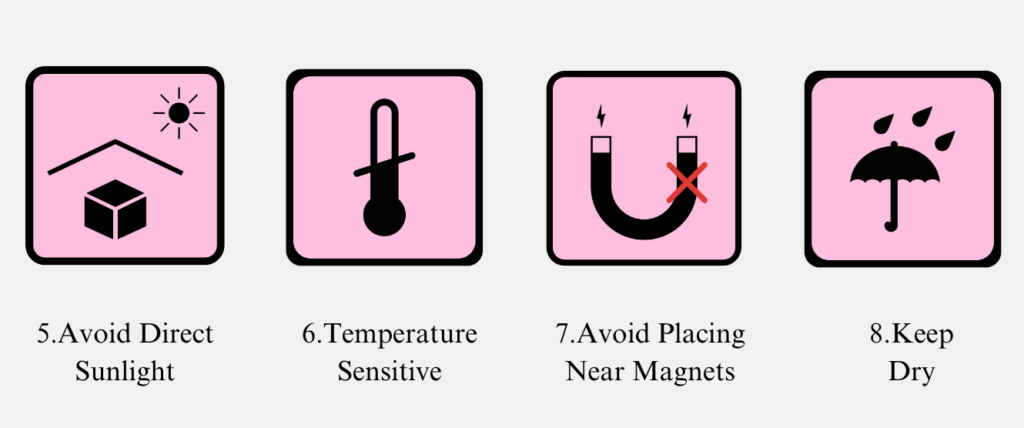
Some packages contain sensitive materials that are vulnerable to environmental effects like water, UV light, or cold. Environmental protection symbols provide instructions for the proper storage of packages.
5. Avoid Direct Sunlight
Sunlight can easily pass through most packaging materials and certain products can degrade from UV exposure.
Examples: Posters, Book Covers, and Liquids.
6. Temperature-Sensitive
Temperature sensitivity markings on a package show the allowable temperature range for storing and shipping the package. This symbol is very important for long-distance and international shipping.
Examples: Food Products and Liquids.
7. Avoid Placing Near Magnets
Sensitive electronics must not be placed near magnets as their magnetic forces can cause serious damage.
Examples: Hard Disk Drives.
8. Keep Dry
This symbol is used for products that must avoid direct contact with water. This symbol will occasionally have just the umbrella, but commonly you will see a raindrop (s) symbol accompanying it.
Examples: Electronics and Paper Products.
Ready to Get Custom Packaging for Your Business?
start with a low minimum order quantity
Category 2 Package Handling Symbols
Handling instructions provide all the necessary information needed to properly transport a package. These instructions are meant for both delivery personnel and customers. The following packaging symbols are commonly found on commercial products that ship together in large quantities.
Package Stacking
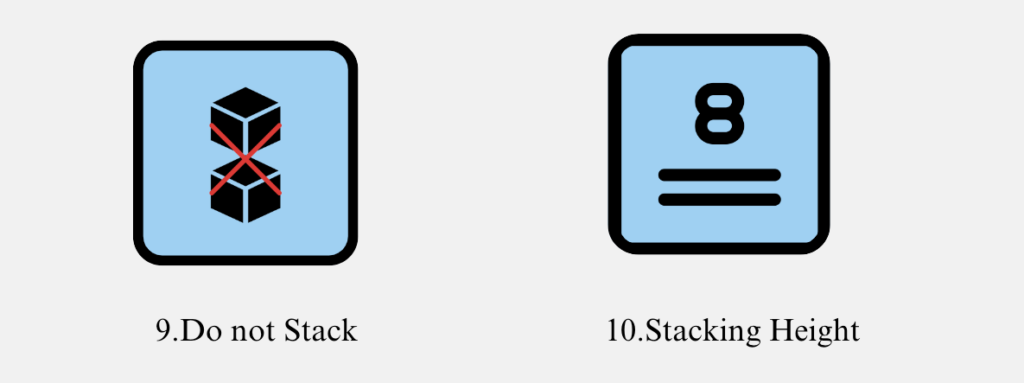
Stacking instructions provide the necessary information for package storage. These instructions play a critical role in keeping the internal contents safe.
9. Do Not Stack
Some packages are designed to prioritize visuals and aesthetics over structural strength. These packages are not meant to be stacked on top of one another, as the packaging material will buckle under the weight. The symbol here shows two boxes stacked, with the top one crossed out.
Examples: Gift Boxes
10. Stacking Height
Even sturdy packaging has its limits and can only withstand a certain amount of weight. Such packages come with a stacking height guide. The symbol here shows multiple items safely stacked up to a certain limit. Here, the number in the middle indicates the maximum allowable stacking height.
Examples: Milk and Juice Cartons.
Weight Information
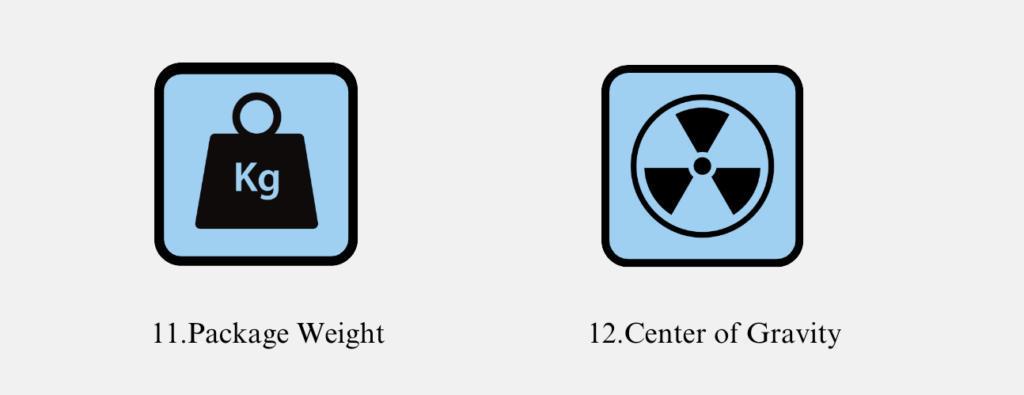
11. Package Weight
For heavier products, the supplier will often list the weight on the box. This symbol prominently shows the total weight with the necessary units.
12. Center of Gravity
The center of gravity is the point where most of the package weight is concentrated. For long packages, the side with this symbol will be heavier, as it carries most of the product weight.
Lifting the Package
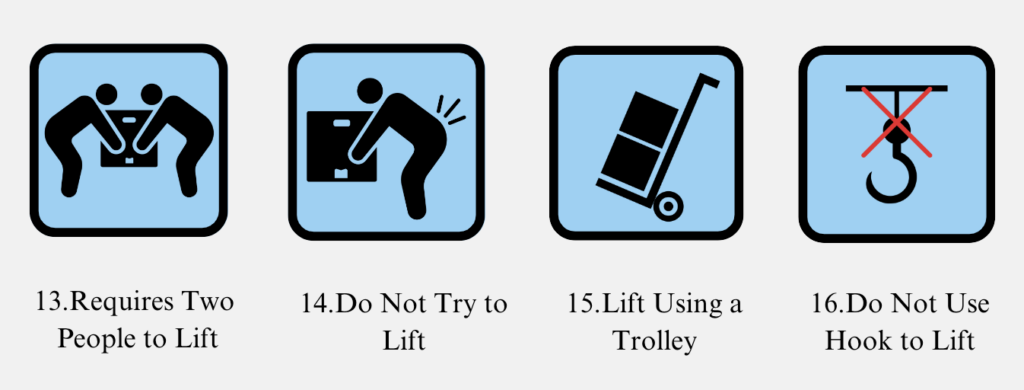
Manufacturers often print moving instructions in the package, which describe the recommended lifting procedure.
13. Requires Two People to Lift
This symbol signifies that a package is either too big or too heavy for a single person to lift. You may be able to lift such packages by yourself, but it is not recommended.
14. Do Not Try to Lift
Packages that are significantly heavy carry the “do not lift” symbol. This symbol is particularly useful for small packages that are deceptively heavy.
15. Lift Using a Trolley
This symbol is used for heavy products that are difficult to carry by hand, even if you have multiple people. Trolleys or weightlifters are strongly recommended for such packages.
16. Do Not Use a Hook to Lift
This symbol is placed on packages that are too large or heavy to be lifted by a hook. Using hooks to carry such packages will cause the bottom of the box to tear open.
Category 3 Health and Safety Symbols
Volatile or ignitable materials need to be declared on the package surface to ensure safety. If your package complies with certain health and safety standards, you can mention them on the box as well.
Product Safety
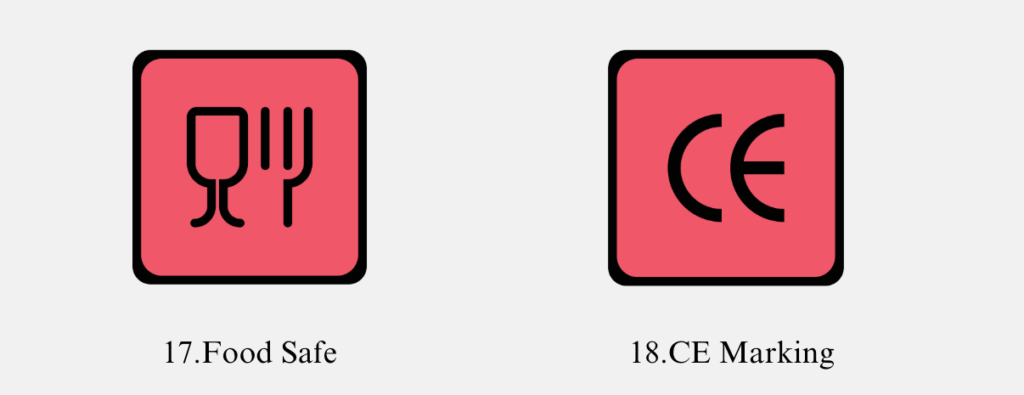
Safety symbols show that the product and packaging have passed some form of quality control inspection.
17. Food Safe
This symbol shows that the packaging material is safe for food packaging. Food safety is a manufacturer’s branding and is not regulated by most countries.
Examples: Fruits and Vegetables.
18. CE Marking
CE stands for conformité européenne (European conformity). Packages that carry this symbol need to comply with European health and safety standards. Using the CE logo without permission can land you in legal trouble.
Potential Hazard
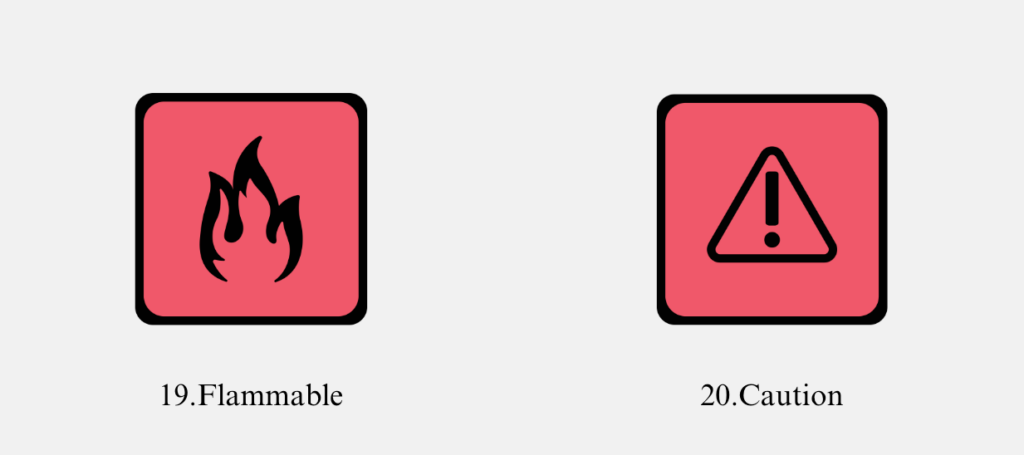
Packages that contain volatile materials or carry the risk of ignition must be printed with hazard warnings. Good packaging correctly conveys all the important information about the handling of a product.
19. Flammable
This symbol is used if the contents of a package contain a risk of flammability.
Examples: Paper Products
20. Caution
This symbol is a general hazard warning and is always accompanied by additional text at the bottom.
Example: Chemicals and Batteries.
Ready to Get Custom Packaging for Your Business?
start with a low minimum order quantity
Category 4 Recycling Details
Recycling details are not mandated by government authorities but are very much appreciated. These international packing symbols apply to both the contents of a package and the cardboard boxes.
Packaging Properties
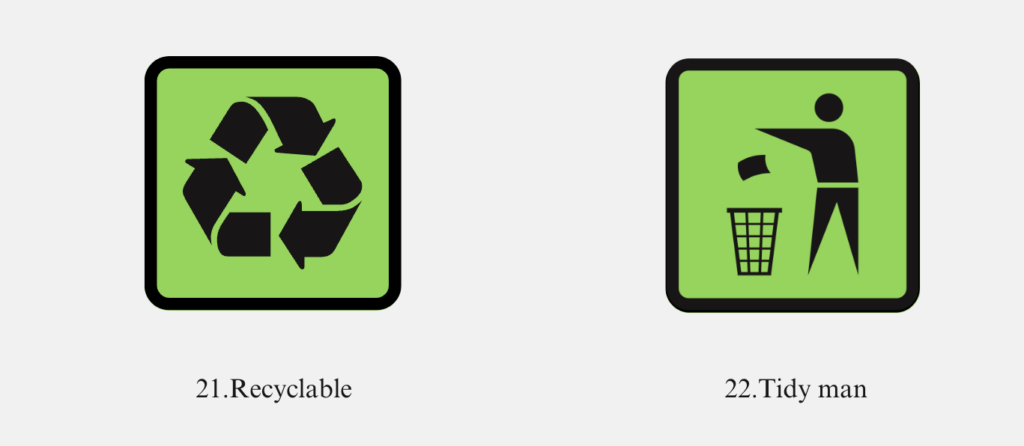
Some recycling symbols show helpful information about the packaging materials.
21. Recycle Symbol
This Mobius loop symbol shows that the packaging material is recyclable in theory. A percentage symbol in the middle of the symbol shows the percentage of recycled material incorporated into the packaging.
22. Tidy Man Symbol
This symbol is just a gentle reminder that you should properly dispose of the packaging. In the UK, the tidy man is an easily recognized symbol, but other countries may find it out of place.
Package Certifications
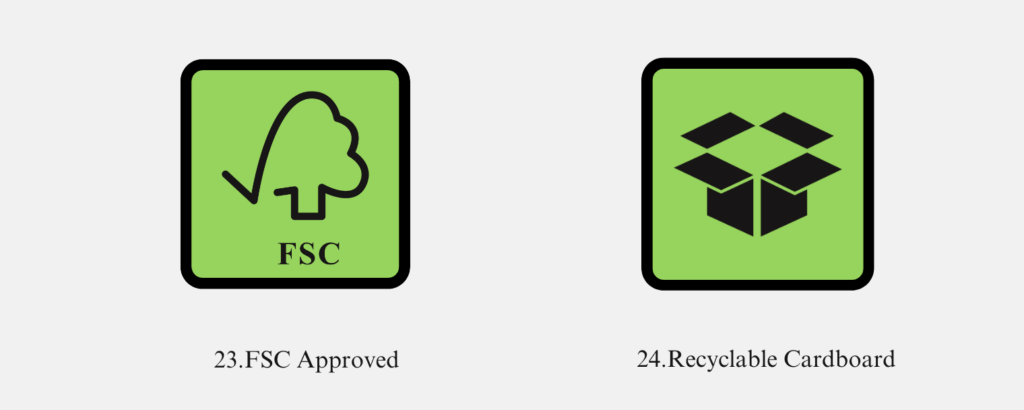
If the package has been certified by a third party, you can print its symbol on it.
23. FSC (Forest Stewardship Council)
The FSC will certify that the product packaging uses wood from well-managed forests. It ensures that the packaging meets the necessary sustainable criteria. It is not a legally mandated standard.
Note: Permission from the FSC is required before using their symbol.
24. Recyclable Cardboard
This symbol shows that the cardboard packaging material is recyclable. It does not indicate if the packaging is made from recycled cardboard. Other unofficial cardboard packaging symbols exist to inform customers that they are made of recycled materials.
Plastic Recycling Symbols
These packaging symbols convey information that is crucial to local recycling efforts. You can specifically relate these plastic types to your carbon footprint. Plastic-type symbols are similar to a Mobius loop but with a number in the center.
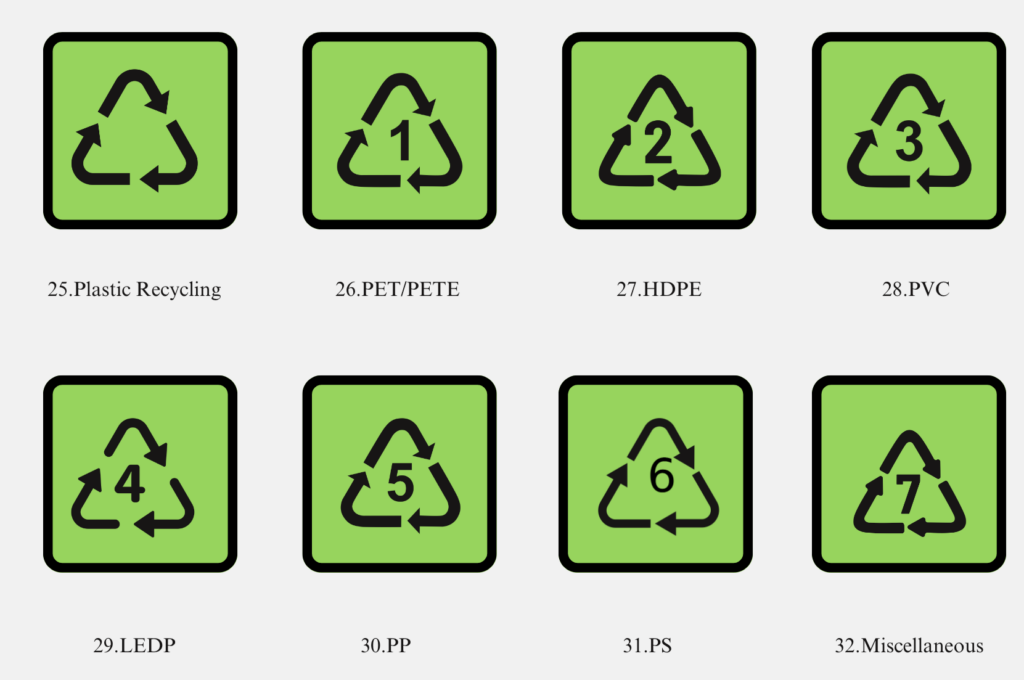
25. Plastic Recycling
The plastic recycling symbol is a guide to help you find the type of plastic material used in the manufacturing of your product. The following is a simple table showing the different symbols and their corresponding details.
Plastic Types
| Plastic | Application | Recyclability |
|---|---|---|
| 26. PET/PETE Polyethylene Terephthalate | Water Bottles, Condiment Containers & Mouthwash Bottles | Great |
| 27. HDPE (High-Density Polyethylene) | Milk and Juice Containers, Plastic Bags & Shampoo Bottles | Great |
| 28. PVC Polyvinyl Chloride | Drain Pipes, Automotive Interiors & Medical Devices | Good |
| 29. HDPE High-Density Polyethylene | Toothpaste Tubes, Furniture, Freezer Safe Food Bags | Poor |
| 30. PP Polypropylene | Bottle Caps, Straws, & Medicine Bottles | Good |
| 31. PSPolystyrene | Disposable Cup, Plates, Egg Cartons & Take containers | Very Poor |
| 32. LDPE (Low-Density Polyethylene) | CD, DVD, Sunglasses & Nylon Products | Very Poor |
Conclusion
Packaging symbols are vital for ensuring proper handling, safety, and environmental responsibility during shipping. Recognizing these symbols helps prevent damage, ensures compliance with safety standards, and improves customer experience.
With this guide, you now have the tools to make informed decisions when choosing packaging symbols, ultimately protecting your products and optimizing the shipping process.
Why Choose Packoi for your Packaging Needs?
Packoi is your one-stop shop for custom packaging and printing solutions. We offer a wide range of fully customizable box and bag designs. Our low MOQs and fast turnaround times are second to none.
A successful business requires high-quality packaging services that showcase its brand in the best light. Choose Packoi for our best-in-class customer service. Contact us Now!



